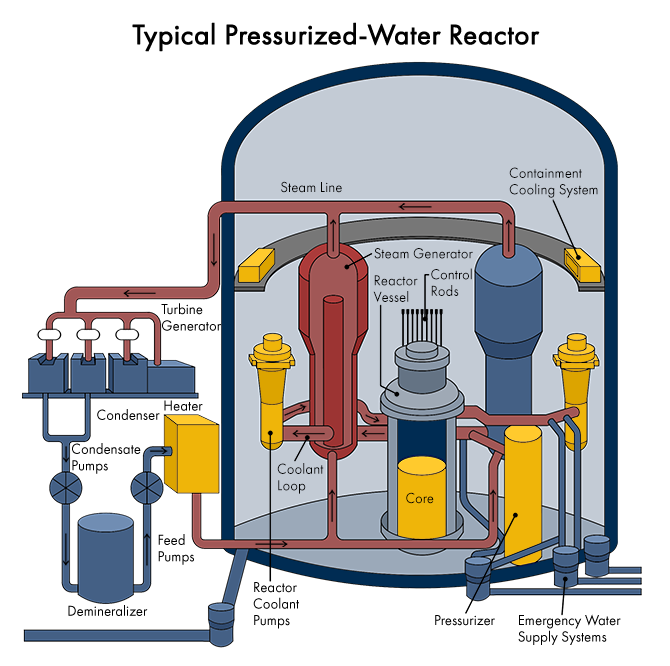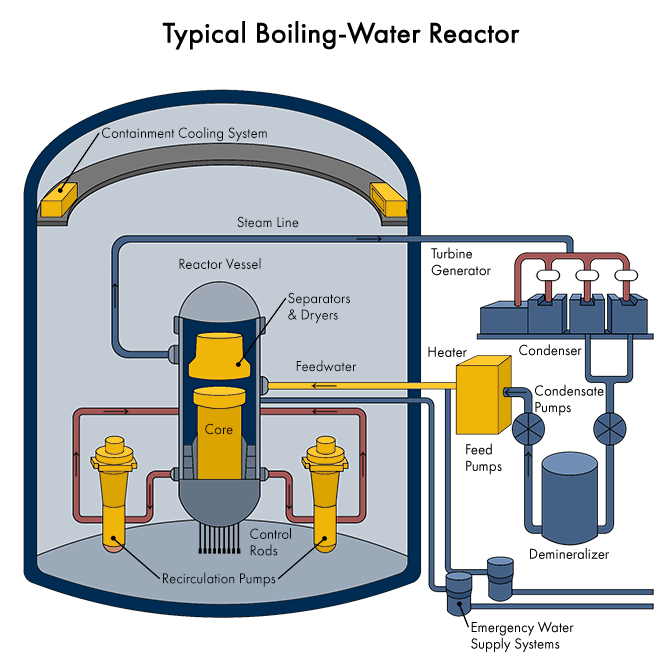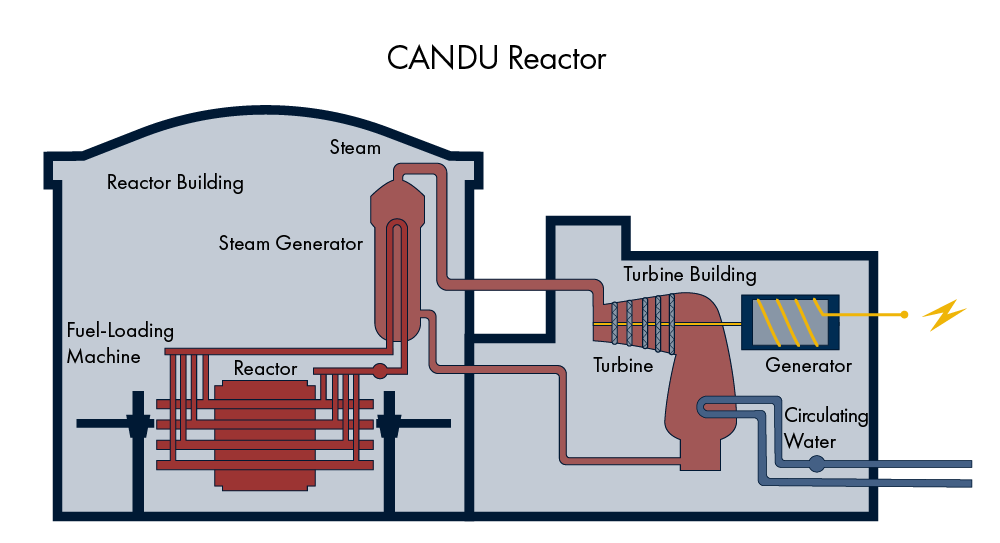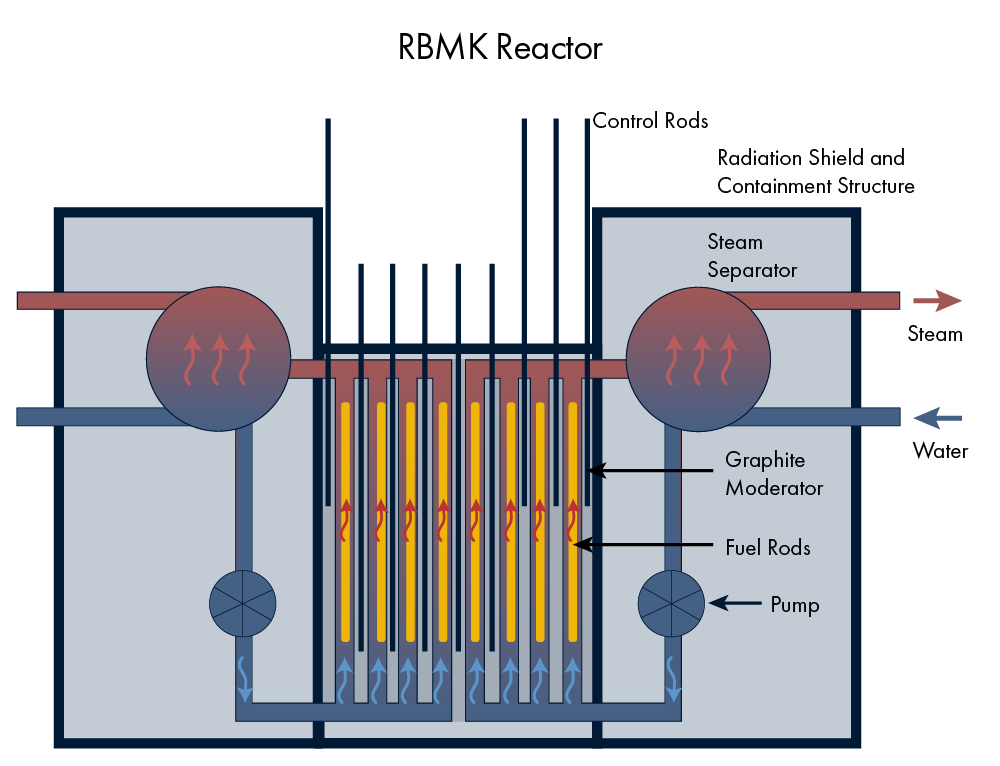Types of Reactors

The design of the pressurized water reactors, which also are the WWER reactors, is with two circuits. The coolant (water) from the primary circuit doesn’t drive the turbine but heats up the water from the secondary circuit. The produced steam in the secondary circuit drives the turbine. The fuel used is Uranium dioxide.
The fission in the uranium fuel releases heat, which is absorbed by the cooling water during its movement upstream through the core. Due to the high pressure in the primary circuit the water doesn’t boil. It circulates between the reactor core and the steam generator, driven by main circulation pumps. In the steam generators the primary coolant heats the water from the secondary circuit and it starts to boil due to the lower pressure on the secondary side. The produced steam is then directed to the turbine, which drives the generator for electricity production. After the turbine, the steam cools down and condenses into water in a condenser. From the condenser the water is pumped back to the steam generators.
Boiling water reactor

The boiling water reactors have one circuit scheme. The cooling water that passes through the reactor core is the source for the steam that drives the turbine. The fuel used in these reactors is uranium dioxide.
The fission in the uranium fuel releases heat, which is absorbed by the cooling water during its movement upstream through the core. The coolant absorbs the heat from the core and starts to boil and produces a steam-water mixture. The steam line leads the produced steam to the turbine, which drives the generator for electricity production. After the turbine, the steam cools down and condenses into water in a condenser. From the condenser the water is pumped back to the reactor.

Heavy-water reactor (CANDU)
For coolant in this type of reactors is used pressurized heavy water. As it is in the PWRs the cooling water from the primary circuit doesn’t drive the turbine but heats up the light water from the secondary circuit. The primary coolant heats the water from the secondary circuit in the steam generators, and due to the lower pressure it starts to boil. The produced steam is then directed to the turbine, which drives the generator for electricity production.
The main difference between the CANDU and the other types of reactors is that the heavy-water reactors use natural uranium for fuel. The fuel bundles are 10 cm in diameter and 50 cm in length, which are loaded into horizontal channels surrounded by heavy water, used for moderator. In the channels circulates pressurized heavy water (coolant). Another CANDU special feature is that they don’t have to be stopped for refueling. A refueling machine loads the new fuel from one side of the channel and discharges the spent fuel from the other during operation.

Water-cooled, graphite-moderated reactor (RBMK)
Water-cooled, graphite-moderated reactor (RBMK) (Реактор Большой Мощности Канальный – High power channel reactor in Russian)
Water-cooled, graphite-moderated reactor (RBMK) (Реактор Большой Мощности Канальный – High power channel reactor in Russian)
For moderator in this type of reactors is used graphite and for coolant – light water. The fuel is low enriched uranium compound, situated in channels in graphite blocks. Circulation pumps drive the water trough the channels it heats up and starts to boil and the steam-water mixture leaves the reactor core with a temperature of about 290 °C. From the reactor it is directed to the separators (a device that separates the steam from the water) and then to the turbine, which drives the generator for electricity production. The coolant is then pumped back to the reactor.
After the Chernobyl accident, a number of measures have been taken to enhance the safety of the RBMK reactors, which are still in operation. The only country besides the Russian federation that owns RBMK reactors is Lithuania. There are two reactors, one of them is shut down and the other is going to be in operation till 2009.

 Български
Български
